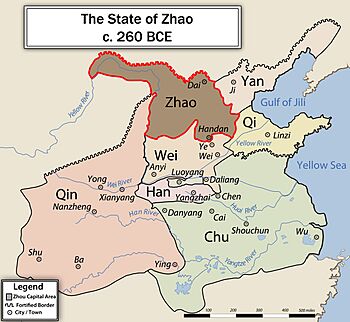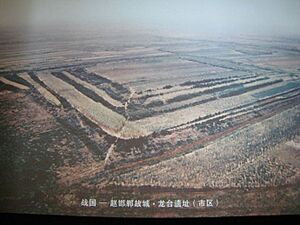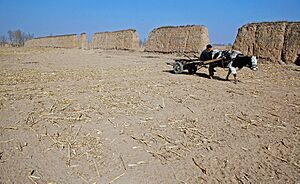Zhao (state) facts for kids
Quick facts for kids
State of Zhao
趙
|
|||||||||||
|---|---|---|---|---|---|---|---|---|---|---|---|
| 403 BC–222 BC | |||||||||||
 |
|||||||||||
| Status | March → Kingdom | ||||||||||
| Capital | Jinyang, Handan | ||||||||||
| Religion |
|
||||||||||
| Government | Monarchy | ||||||||||
|
• 423 BCE - 409 BCE (first)
|
Marquess Xian of Zhao | ||||||||||
|
• 403 BCE - 400 BCE
|
Marquess Lie of Zhao | ||||||||||
|
• 386 BCE - 375 BCE
|
Marquess Jing of Zhao | ||||||||||
| Historical era | Warring States period | ||||||||||
| 403 BC | |||||||||||
|
• Conquered by Qin
|
222 BC | ||||||||||
| Currency |
|
||||||||||
|
|||||||||||
| Zhao | |||||||||||||||||||||||||||||
|---|---|---|---|---|---|---|---|---|---|---|---|---|---|---|---|---|---|---|---|---|---|---|---|---|---|---|---|---|---|

"Zhao" in seal script (top), Traditional (middle), and Simplified (bottom) Chinese characters
|
|||||||||||||||||||||||||||||
| Traditional Chinese | 趙 | ||||||||||||||||||||||||||||
| Simplified Chinese | 赵 | ||||||||||||||||||||||||||||
|
|||||||||||||||||||||||||||||
Zhao (traditional Chinese: 趙; simplified Chinese: 赵) was one of the seven most important states in ancient China. It existed during the Warring States period, a time when different states fought for control. Zhao became a state in the 5th century BC, after the large Jin state split into three parts. The other two parts were Han and Wei.
Zhao grew much stronger thanks to military changes made by King Wuling of Zhao. However, it faced a huge defeat against the Qin state at the Battle of Changping. Zhao's land covered parts of what are now Inner Mongolia, Hebei, Shanxi, and Shaanxi provinces. Its capital city was Handan.
Zhao was also home to important thinkers. These included Shen Dao, who focused on how to run a government, and Xun Kuang, a follower of Confucian ideas.
Contents
How Zhao Began
The Zhao family was a powerful clan within the Jin state for many centuries. They slowly gained more power. They even took over a smaller state called Dai in the mid-5th century BC.
Around 403 BC, the Jin state was divided among three powerful families. One of these was the Zhao family, led by Zhao Xiangzi. The king of Zhou officially recognized Zhao as its own state, along with Han and Wei. Many historians believe this event marked the start of the Warring States period.
At first, Zhao was one of the weaker states. Even though it had a lot of land, its northern border was often attacked by nomadic groups. These included the Eastern Hu, Loufan, and Xiongnu peoples. Zhao was not as strong as Wei or as rich as Qi. It often got caught in fights between these bigger states. For example, in 354 BC, Wei attacked Zhao. Zhao had to ask Qi for help. This led to the Battle of Guiling, which Qi won. This victory helped make Zhao's southern border safer.
Becoming Stronger
Zhao stayed fairly weak until King Wuling of Zhao made big changes to the military. This happened between 325 BC and 299 BC. King Wuling ordered his soldiers to dress like their nomadic neighbors, the Hu people. He also told them to stop using war chariots and instead use cavalry archers. This meant soldiers on horseback who could shoot arrows. This change was very smart. By combining Chinese technology with the fighting styles of the nomads, Zhao's cavalry became very powerful. This new strength helped Zhao stand up to its biggest rival, Qi.
Zhao showed its new military power by conquering the state of Zhongshan in 295 BC. This was after a long war. Zhao also took land from its neighbors, Wei, Yan, and Qin. During this time, Zhao's cavalry sometimes even raided Qi during campaigns against Chu.
Zhao had several brilliant military leaders at this time. These included Lian Po, Zhao She, and Li Mu. Lian Po was key in defending Zhao from Qin. Zhao She mostly fought in the east, leading an invasion of Yan. Li Mu protected Zhao from the Xiongnu in the north and later from Qin.
The Fall of Zhao
By the end of the Warring States period, Zhao was the only state strong enough to challenge the mighty Qin. Zhao and Wei formed an alliance against Qin in 287 BC, but they were defeated in 273 BC. The biggest and bloodiest battle of this time was the Battle of Changping in 260 BC. Zhao's army was completely crushed by Qin. Even though the armies of Wei and Chu later saved Handan from a Qin siege, Zhao never fully recovered from losing so many soldiers.
In 229 BC, the Qin general Wang Jian led invasions against Zhao. Zhao's generals Li Mu and Sima Shang fought back well until 228 BC. Li Mu was one of the best generals of the Warring States period. He could not defeat Wang Jian, but Wang Jian also could not advance. The fight was stuck. The Qin emperor, Qin Shihuang, knew he had to get rid of Li Mu to conquer Zhao. He secretly tried to cause trouble among Zhao's leaders.
The Zhao king, Youmiu, fell for the trick. He listened to disloyal officials and Qin spies. He ordered Li Mu to be killed and removed Sima Shang from his job. Li Mu's replacement, Zhao Cong, was quickly defeated by Wang Jian. Qin captured King Youmiu and defeated Zhao in 228 BC.
King Youmiu's half-brother, Prince Jia, was then made King Jia in Dai. He led the last Zhao forces against Qin. This last part of Zhao lasted until 222 BC. That's when the Qin army captured him and defeated his forces in Dai.
Later, during the Qin dynasty, a rebel named Wu Chen declared himself King of Zhao. He was later killed by one of his own officers. Other former Zhao officials, Zhang Er and Chen Yu, then made a royal family member, Zhao Xie, the new King of Zhao.
In 206 BC, a rebel lord named Xiang Yu defeated the Qin dynasty. He made himself and seventeen other lords into kings. Zhao Xie became the king of Dai. Chen Yu helped Zhao Xie get back the land of Zhao from Zhang Er. So, Zhao Xie made Chen Yu the Prince of Dai. In 205 BC, Chen Yu's officer was defeated by generals of Liu Bang. Chen Yu was defeated in 204 BC, and Zhao Xie was killed by Liu Bang's forces. Liu Bang then gave the state of Zhao to Zhang Er.
Much later, in 154 BC, a different Zhao kingdom, led by Prince Liu Sui, took part in a rebellion. This rebellion was against the new Han dynasty emperor, but it failed.
Culture and Society

Before Qin Shi Huang united China in 221 BC, each region had its own customs. However, the culture of the ruling class was similar everywhere. Ancient texts describe China as having nine regions, each with unique people and products. These texts suggest that these regions were united by a great leader, Yu the Great. Each region sent its special goods to the capital as tribute.
One important text, Wuzi, was a military book from the Warring States period. It explained that the government and people's nature were connected to their land.
About Zhao, the book said:
The two states of Han and Zhao train their troops rigorously but have difficulty in applying their skills to the battlefield.
– Wuzi, Master Wu
Han and Zhao are states of the Central Plain. Theirs are a gentle people, weary from war and experienced in arms, but have little regard for their generals. The soldiers' salaries are meager and their officers have no strong commitment to their countries. Although their troops are experienced, they cannot be expected to fight to the death. To defeat them, we must concentrate large numbers of troops in our attacks to present them with certain peril. When they counterattack, we must be prepared to defend our positions vigorously and make them pay dearly. When they retreat, we must pursue and give them no rest. This will grind them down.
– Wuzi, Master Wu
Rulers of Zhao
Before the Partition of Jin
- Chengzi of Zhao
- Xuanzi of Zhao
- Zhuangzi of Zhao
- Wenzi of Zhao
- Jingzi of Zhao
- Jianzi of Zhao
- Xiangzi of Zhao
- Huanzi of Zhao
After the Partition of Jin
- Marquess Xian (ruled 424 BC–409 BC)
- Marquess Lie (ruled 409 BC–387 BC), known for reforms
- Marquess Jing (ruled 387 BC–375 BC)
- Marquess Cheng (ruled 375 BC–350 BC)
- Marquess Su (ruled 350 BC–326 BC)
- King Wuling (ruled 326 BC–299 BC)
- King Huiwen (ruled 299 BC–266 BC)
- King Xiaocheng (ruled 266 BC–245 BC)
- King Daoxiang (ruled 245 BC–236 BC)
- King Youmiu (ruled 236 BC–228 BC)
- Jia, King of Zhao (ruled 228 BC–222 BC)
- Xie, King of Zhao (ruled 209 BC–205 BC). A king put back in power by rebels.
See also
- Zhao Kingdom (Han dynasty)
- Han-Zhao
- Later Zhao


